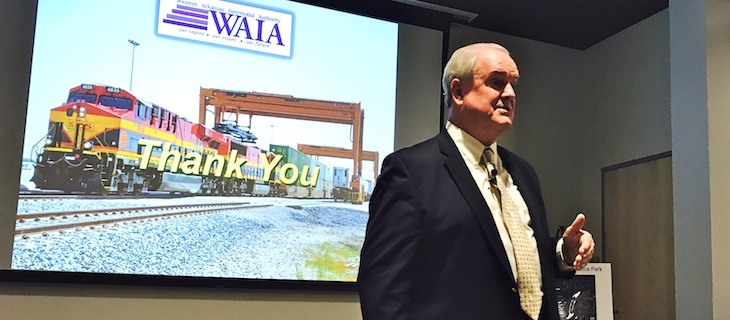Consultant touts public-private partnership for potential Fort Smith port: ‘Do not speculatively develop this facility’
by August 23, 2017 8:52 pm 893 views

John Vickerman of Vickerman and Associates, speaks Aug. 23, 2017. to members of the Western Arkansas Intermodal Authority.
John Vickerman of Vickerman and Associates told stakeholders in the Western Arkansas Intermodal Authority (WAIA) on Wednesday (Aug. 23) the Fort Smith region should pursue its planned intermodal facility “the right way” by utilizing a public-private partnership.
“Do not speculatively develop this facility,” Vickerman warned. “Do not do that. It’s crazy. Do it if you can prove a market-driven scenario.”
Vickerman’s comments were part of his first presentation to the five-member body consisting of the city governments of Fort Smith and Van Buren, Sebastian and Crawford counties, and the Fort Chaffee Redevelopment Authority (FCRA), after being hired for $200,050 in April to evaluate the viability of an intermodal rail, logistics center, warehouse, and integrated riverport terminal in the Fort Smith region.
Vickerman was confident in a “market-driven scenario” for the area, citing access to the Arkansas River, Interstate, rail, and truck all converging near Fort Smith as proof. But for funding, he said, the goal is to attract outside investors and developers.
“We have to find developers and investors, who can see the potential and who are interested,” Vickerman said. “Because what we’re really saying is, ‘We do not have enough money to develop this ourselves, yet we see the value. We want you as developers to see the value.'”
Vickerman cited Centerpoint — one of the largest developers of warehousing and distribution in the U.S. — as an example of where his study’s efforts would need to lead.
“They are the developer, who built the BNSF Logistics Park (in Chicago). They’re owned by the California Retirement Fund, and they do nothing but build warehouse and distribution around railroads. That sounds like something we might be interested in. We need to go to Centerpoint and we need to go to people like that, and we can’t just walk into their office and say, ‘You know, I’m a really good guy and I’ve got some really good people in Fort Smith. Are you ready to invest?’ They’re not going to do that. But if you talk their language and you put the market down and put the capacity against it, and show them that potential, then they will open the door and sit down and talk to you.”
Vickerman said the goal would be to have an entity “come back to us with a proposal and an interest — quite frankly, come back with anything that has triggered their interest in our project.” Any “trigger,” Vickerman added, would give his firm something that could be built upon. “What we may do is take all of these variable interests and amalgamate them into something.”
He continued: “We’re trying to build this through private sector funds. Now it’s going to require some public funds — the access roads — there will be plenty of those kinds of things. But the primary driver here will be private sector funding of this opportunity because at this point, it is not being triggered by the local community.”
What Vickerman said he would like to convey to a developer through his study is that “we’ve looked at the marketplace. We’ve scrubbed it. You can go ahead and scrub it yourself. You have your own dynamics. But we have done that, and the need is this.”
From there, a potential investor would see how an intermodal facility in the area meets their need.
“You could take that need to the New York bond market, and you could actually secure tax-exempt financing through municipal bonds should you so desire,” he hopes to communicate, adding “it’s a pretty powerful formula, and we’ve used it over and over.”
Vickerman has worked as consultant on 67 of the 90 North American deep water ports, including two of the largest in New Orleans and Chicago. The study will conclude with a final report at the first of 2018, after which Vickerman will put a call out for requests for expressions of interest (RFEIs) to find a developer, who would then theoretically bear the cost of building any resulting infrastructure. That interest, if it exists, would start to show sometime in the first quarter of 2018.
